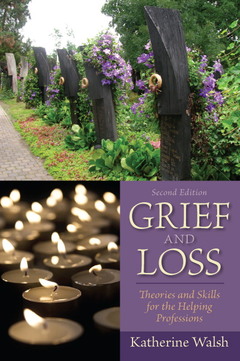Description
Grief and loss (2nd ed ) (2nd Ed.)
Theories and Skills for the Helping Professions
Author: Walsh Katherine
Language: English
Approximative price 76.21 €
In Print (Delivery period: 12 days).
Add to cart216 p. · Paperback
Description
/li>Contents
/li>Biography
/li>Comment
/li>
Provides a variety of case examples applying theory to practice when working with those dealing with grief and loss.
Grief and Loss: Theories and Skills for the Helping Professions, 2/e, allows readers to see how essential theories and skills will enhance their own practice. They will gain the core knowledge and skills needed to work with individuals, families, groups, and communities who are experiencing loss and the grief that accompanies it
Culture, spirituality, age, gender and other factors that influence grief reactions are discussed, helping readers understand and work with diverse populations. Individual and programmatic responses to grieving people are also included. Each chapter contains exercises that encourage readers to apply the concepts learned and MySocialWorkLab includes a variety of Internet resources and supplemental learning tools.
Learning Goals
Upon completing this book, readers should be able to:
- Acquire core knowledge and skills that will prepare readers to work with individuals, families, groups, and communities who are experiencing loss and the grief that accompanies it
- Understand normal and complicated grief reactions
- Identify actual as well as symbolic losses
- Recognize the factors the positively and negatively influence grief reactions
- Understand the resources and interventions that are effective in helping those who are grieving
IN THIS SECTION:
1.) BRIEF TABLE OF CONTENTS
2.) FULL TABLE OF CONTENTS
BRIEF TABLE OF CONTENTS:
Chapter 1: Introduction to Grief and Loss
Chapter 2: Symbolic Loss
Chapter 3: Self Preparation and Training for Professionals
Chapter 4: Childhood and Adolescence
Chapter 5: Young and Middle Adulthood
Chapter 6: Older Adulthood
Chapter 7: Normal and Complicated Grief
Chapter 8: Culture and Spirituality
Chapter 9: Anticipatory Grief in End of Life Care
Chapter 10: What Can We Do to Help Grieving Individuals and Families?
Chapter 11: Helping Groups and Organizations Cope with Grief
Chapter 12: Communities and Traumatic Grief
Chapter 13: Professional Resilience: Sustaining Hope, Helpfulness and Competence in Working With Grief
FULL TABLE OF CONTENTS:
Chapter 1: Introduction to Grief and Loss
Basic Facts About Loss
Why Study Grief?
Experiences That Generate Grief Reactions
Summary
Chapter 2: Symbolic Loss
Symbolic Loss
Similarities And Differences In Symbolic And Actual Losses
Summary
Chapter 3: Self Preparation and Training for Professionals
Reviewing Our Own Experiences and Attitudes Related To Grief
Assessing and Enhancing Our Readiness to Address Grief
Increased Recognition of the Impact of Grief on Professionals
Supervision, Consultation and Collaboration
Summary
Chapter 4: Childhood and Adolescence
Loss in the Formative Years
External Factors Influencing Grief in Children and Adolescents
The Influence of Development on Grief Reactions
Grief Reactions at Different Developmental Stages
Summary
Chapter 5: Young and Middle Adulthood
Factors in addition to age and developmental stage that influence grief reactions.
Developmental and External Factors influencing grief reactions
Summary
Chapter 6: Older Adulthood
Loss and Grief Later In Life
The Influence of Advanced Age and Longer Life Expectancy
Symbolic and Actual Loss for Older Adults
Working with Grieving Older Adults
Summary
Chapter 7: Normal and Complicated Grief
Theories That Inform Our Understanding Of Grief
Common Reactions in “Normal” Grief
“Complicated Grief”
Interventions for Normal and Complicated Grief
Summary
Chapter 8: Culture and Spirituality
The Influence of Culture and Spirituality in Coping with Loss and Grief
Culture
Culture Awareness, Sensitivity, and Competence Gender and Media Influences
Spirituality
Summary
Chapter 9: Anticipatory Grief in End of Life Care
Anticipated Loss In Diverse Practice Settings
“Anticipatory Grief”
End of Life and Palliative Care
Advance Directives
Summary
Chapter 10: What Can We Do to Help Grieving Individuals and Families?
Misconceptions About Grief
Empathic Communication
Interventions for Normal and Complicated Grief
Bereavement Counseling
Grief Therapy
Collaborating With Other Helping Professionals
Summary
Chapter 11: Helping Groups and Organizations Cope with Grief
Group Models
Identifying and Developing Organizational Resources
Establishing a Bereavement Protocol: Interdisciplinary and Inter-Organizational Collaboration
Summary
Chapter 12: Communities and Traumatic Grief
Trauma
Post-Traumatic Stress Disorder (PTSD)
When Communities Experience Trauma and Grief
Creating Remembrances and Memorials
Summary
Chapter 13: Professional Resilience: Sustaining Hope, Helpfulness and Competence in Working With Grief
Continuing Education And Professional Development
Self-Care
Professional Support Systems
Summary
Appendices
Appendix A: Common Losses Across the Lifespan
Appendix B: Helpful Strategies for Coping with Grief
Appendix C: Strategies for Professionals Helping Children and Families Cope with Traumatic Loss
Appendix D: Remembrance Celebrations: Planning Your Own or Someone Else’s Memorial Service
Appendix E: Expressive Techniques
Appendix F: Caregivers Retreat Agenda and Invitation
Internet Resources
Annotated Bibliography
APPLY THEORY TO PRACTICE WHEN WORKING WITH THOSE DEALING WITH GRIEF AND LOSS
- Case examples illustrate theories and skills, allowing the students to see how these theories will enhance in their own practice. (ex. p. 3)
- Individual and programmatic responses to grieving people are included (ex. p. 5-6)
- Culture, spirituality, age, gender and other factors that influence grief reactions are discussed, preparing students to understand and work with diverse populations.
- Instructor's Manual and Test Bank and PowerPoint Slides are available with the text




